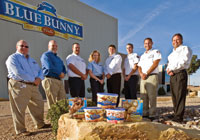Teamwork sets high productivity, quality, safety standards at Wells’ Dairy in St. George, Utah.

Walk into any ice cream plant and what stands out is sanitary process equipment – massive, bright silver mix tanks, filling lines, piping and more. Then again, it’s the employees who truly stand out at a Wells’ Dairy Inc. plant in St. George, Utah.
Recognized as Dairy Field Reports' 2009 Plant of the Year, this six-year-old operation annually produces more than 200,000 pounds of packaged Blue Bunny ice cream, sherbet and frozen yogurt. In the far southwest corner of Utah – two hours from Las Vegas and four hours from Salt Lake City – St. George allows Wells’ Dairy, Le Mars, Iowa, to cut distribution time in half to the West Coast.
“The primary purpose of the facility is for high-altitude production while also providing a manufacturing facility and freezer to supply customer demands as we look to any possible future westward expansion,” says Ken Kaneversky, plant manager.
Completed in 2003, St. George has grown to 161,000 square feet with 94 people. Interestingly enough, this flexible facility uses just three filling lines to produce a multitude of SKUs.
While not as vast as the massive “South Plant” back home in Le Mars, where Wells operates two manufacturing facilities, the St. George plant is nimble and flexible, with a skilled work force dedicated to safety, quality and continuous improvement.
In fact, plant managers credit much of their facility’s success to the sense of ownership demonstrated by the work force.
“Rather than operators, we have ‘line owners,’ who are responsible for the progress of each line,” says Kaneversky. “Every line has an owner, whether the manufacturing side or the maintenance side, to make sure they meet pre-established requirements.”
Each owner is responsible for making sure their domain meets goals for SQDC, or safety, quality, delivery and cost. Officials note that each production line has its own results board to track SQDC performance.
Supervisors express great pride in their team hitting the mark on each one of those areas.
“Employee safety is of utmost importance in everything we do and is at the forefront of every professional that works in the plant,” Kaneversky says. “In short, the St. George ice cream plant is a community where safety is based upon personal responsibility for oneself and a deep concern for others. It is also important to note that safety is employee driven – driven from the bottom-up. We have a great safety record and intend to keep it that way.”
Adds Freezer Manager Richard Streker, “We’re most proud of this team going over 700 days without a reportable incident,” noting the two-year anniversary of that achievement was shortly before Thanksgiving. Streker and his colleagues are similarly proud of the plant’s exception (operational error) rate, which to date is less than one-half of 1 percent.
Speaking of quality, Wells expects operators to bring any production concerns to their supervisors’ attention, and every team member has the ability to stop the line for food safety or quality issues, Kaneversky says.
The St. George plant is Level 3 certified for the SQF (Safe Quality Food) program recognized by the Global Food Safety Initiative and managed by the Food Marketing Institute.
“Delivery” is how the plant measures attainment of goals versus its schedule.
“We’ve raised it 10 percent in the past year,” notes Plant Controller Paul Valenzuela. “We’re over 92, 93 percent every week.”
Meanwhile, the plant holds quarterly contests between teams and gives awards to those achieving the greatest cost savings.
“The factory has done extremely well controlling costs,” says Kaneversky. “We’ve broken records the last two years.”
Kaneversky informs team members about plant and company news in “Ken’s Korner,” a monthly newsletter he posts on the employee bulletin board. The newsletter is displayed near the management’s own action register, “so the team can hold the leadership accountable,” for their responsibilities as well, he notes.
Above all is posted the plant’s mission statement: safely making and delivering quality ice cream right the first time. To that end, the St. George plant uses a self-managed model of training that encompasses safety, quality, technical and leadership roles.
“Front-line professionals have a broad spectrum of responsibilities,” notes Kaneversky. “Employees are also accountable for understanding their training needs, reaching out to experts in the plant to receive training and documenting that training has been completed. This personal accountability motivates employees to become better at what they do each day. Such accountability in turn allows management to focus more on continuous improvement efforts at the plant helping St. George become one of the best managed manufacturing facilities in the country.”
The company has turned basic training into professional development.
“It has changed employees’ attitudes,” says Lesley Bartholomew, employee communications manager. “They see it as a career.”
In fact, the folks at St. George see this as the plant’s most significant innovation.
“The St. George facility has a very evolved and unique self-directed training program that allows those in the operations and freezer teams to advance in their knowledge and professional development at an accelerated pace,” Kaneversky says.
This article was excerpted from Dairy Field Reports’ December 2009 issue. The article was written by Chief Editor James Dudlicek.
At a glance
Company: Wells’ Dairy Inc.
Food plant(s) honored: St. George, Utah
Selection criteria: Productivity, process innovation, employee programs
Employees: 94
Facility size: 161,000 square feet
Products: Ice cream, sherbet, frozen yogurt
